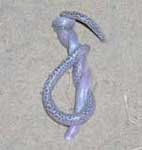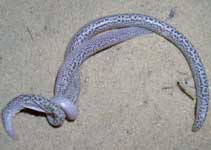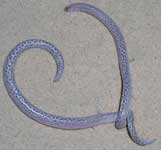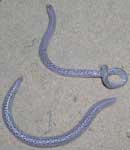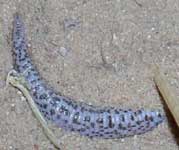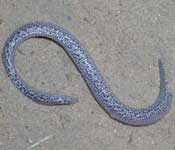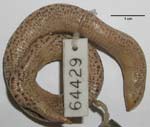The imagery on this page was the basis for a paper entitled Cranial anatomy of the spade-headed amphisbaenian Diplometopon zarudnyi (Squamata, Amphisbaenia) based on high-resolution X-ray computed tomography, by J. A. Maisano, M. Kearney and T. Rowe (Journal of Morphology 267:70-102, 2006). The abstract is as follows:
The skull of the trogonophid amphisbaenian Diplometopon zarudnyi is described from high-resolution X-ray computed tomographic (HRXCT) imagery of a whole museum specimen preserved in ETOH. The skull was digitally resliced and disarticulated into individual elements (see Additional Imagery), producing novel visualizations that allow detailed morphological analysis of its three-dimensionally complex structure. The prefrontal and jugal are absent in Diplometopon. The septomaxilla is present but hidden entirely from superficial view. In contrast to previous studies, we recognize a splenial fused to the compound bone of the mandible and a squamosal fused to the otic-occipital complex. Comparison of Diplometopon to the two other amphisbaenians previously described in comparable detail, Rhineura hatcherii and Amphisbaena alba, reveals a mosaic of cranial similarities and differences. Both Diplometopon and Rhineura exhibit a craniofacial angulation and expanded rostral blade related to use of the head as a digging tool, but the detailed architecture of these features is quite different. Additionally, whereas the snout of Rhineura exhibits a high degree of sculpturing and sensory innervation, this is not the case in Diplometopon. Unlike in Rhineura and Amphisbaena, the cranial elements of Diplometopon do not exhibit an extensive degree of overlap or complex interlocking sutures; instead, most of the cranial elements lie in loose apposition to each other. The degree to which this mosaic of features reflects functional demands, shared ancestry, and/or convergence is unclear in the absence of a stable hypothesis of amphisbaenian phylogeny.
DigiMorph Account of Diplometopon
Additional images of Diplometopon zarudnyi were sent to DigiMorph by Danny Fidler of the United States Air Force. The photos were taken May
28, 2004 around 11 pm in the vicinity of Umm Qasr in southern Iraq.
Staff Sargent Fiddler described the behavior as follows:
"Last night I found two worm lizards while I was doing my rounds. I believe
they were mating as you can see by the pictures. However I am not sure.
... When the larger of the two was done doing whatever it was it was
doing, it released the smaller one. However they were facing each other
'head-to-toe' in the photos. Instead of them grasping each other by what I
thought was there genitalia, the larger ones jaw was grasping the bottom
portion of the smaller one. And on a few photos, you can see where the last
few centimeters of the smaller lizard appeared to be sunken in a bit along
the spine, almost like the larger one was sucking fluids from it."

Literature
Bellairs Ad'A, Gans C. 1983. A reinterpretation of the amphisbaenian orbitosphenoid. Nature (London) 302:243244.
Berman DS. 1973. Spathorhynchus fossorium, a Middle Eocene amphisbaenian (Reptilia) from Wyoming. Copeia 1973:704-721.
Berman DS. 1976. A new amphisbaenian (Reptilia: Amphisbaenia) from the Oligocene-Miocene John Day Formation, Oregon. J Paleo 50:165-174.
deBeer GR. 1937. The development of the vertebrate skull. Oxford: Oxford University Press. 552 p.
El-Assy YS, Al-Nassar NA. 1976. Morphological study of the cranial osteology of the
amphisbaenian Diplometopon zarudnyi. Journal of the University of Kuwait (Sci) 3:113-141.
Estes R, de Queiroz K, Gauthier J. 1988. Phylogenetic relationships within Squamata. In: Estes R, Pregill G, editors. Phylogenetic relationships of the lizard families: essays commemorating Charles L. Camp. Stanford: Stanford University Press. p 119281.
Gans C. 1960. Studies on amphisbaenids (Amphisbaenia, Reptilia). 1. A taxonomic revision of the Trogonophinae and a functional interpretation of the amphisbaenid adaptive pattern. Bulletin of the American Museum of Natural History 119:129204.
Gans C. 1974. Biomechanics. An approach to vertebrate biology. Philadelphia: JP
Lippincott. 261 p.
Gans C. 1978. The characteristics and affinities of the Amphisbaenia. Transactions of the Zoological Society of London 34:347416.
Jollie MT. 1960. The head skeleton of the lizard. Acta Zool 41:164.
Kearney M. 2003. Systematics and evolution of the Amphisbaenia (Reptilia: Squamata) based on morphological evidence from fossil and living forms. Herpetological Monographs 17:1-75.
Kearney M, Maisano JA, Rowe T. 2005. Cranial anatomy of the extinct amphisbaenian Rhineura hatcherii (Squamata, Amphisbaenia) based on high-resolution x-ray computed tomography. Journal of Morpholology Early View.
Kearney, M, Stuart B. 2004. Repeated evolution of limblessness and digging heads revealed by DNA from old bones. Proceedings of the Royal Society of London Series B 271:1677-1683.
Kesteven L. 1957. Notes on the skull and cephalic muscles of the Amphisbaenia. Proc Linn Soc New South Wales 82:109116.
Kritzinger CC. 1946.
The cranial anatomy and kinesis of the South African amphisbaenid
Monopeltis capensis Smtih. S Afr J Sci 42:175-204.
Lakjer T. 1927. Studien όber die Gaumenregion bei Sauriern im Vergleich mit Anamniern und primitiven Sauropsiden. Zool Jahrb (Anat) 49:57356.
Montero R, Gans C. 1999. The head skeleton of Amphisbaena alba Linnaeus. Annals of the Carnegie Museum 68:1580.
Montero R, Gans C, Lions M. 1999. Embryonic development of the skeleton of
Amphisbaena darwini heterozonata (Squamata:Amphisbaenidae). Journal of Morphology 239:125.
Oelrich TM. 1956. The anatomy of the head of Ctenosaura pectinata (Iguanidae). Miscellaneous Publications of the Museum of Zoology, University of Michigan 94:1122.
Vanzolini PE. 1951. Evolution, adaptation and distribution of the amphisbaenid lizards (Sauria: Amphisbaenidae). Thesis, Harvard University. 148 p.
Zangerl R. 1944. Contributions to the osteology of the skull of the Amphisbaenidae. American Midland Naturalist 31:417454.
Links
Trogonophidae page from the EMBL Reptile Database









